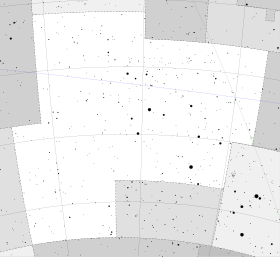HR 7703
Coordinates:  20h 11m 11.93827s, −36° 06′ 04.3610″
20h 11m 11.93827s, −36° 06′ 04.3610″
| Observation data Epoch J2000 Equinox J2000 | |
|---|---|
| Constellation | Sagittarius |
| Right ascension | 20h 11m 11.93827s[1] |
| Declination | –36° 06′ 04.3610″[1] |
| Apparent magnitude (V) | 5.31[2]/11.50[3] |
| Characteristics | |
| Spectral type | K2.5 V[4] + M4 V[5] |
| U−B color index | +0.43[2] |
| B−V color index | +0.85[2] |
| Absolute magnitude (MV) | 6.53[8] |
| Details | |
| HR 7703 A | |
Gyr | |
| HR 7703 B | |
| Mass | 0.24[11] M☉ |
| Radius | 0.28[3] R☉ |
LTT 7988 | |
| HR 7703 B: LHS 487, LFT 1530, LTT 7989 | |
| Database references | |
| SIMBAD | The system |
| A | |
| B | |
Location of HR 7703 in the constellation Sagittarius | |
HR 7703 (Gliese 783, 279 G. Sagittarii) is a
Based upon an annual
velocity of approximately 129 kilometers per second.[6] At this rate, it will make its closest approach in 41,100 years when it comes to within 6.7 light-years (2.05 parsecs) of the Sun.[13]
This star system has been examined for an excess of radiation in the infrared. The presence of an infrared excess can be taken as an indication of a debris disk orbiting the star. However, no such excess was discovered around HR 7703.[14] Radial velocity data collected over a period of 12 years was examined for signs of periodicity caused by a planet orbiting at a distance of 3–6 AU, but none was detected.[15] A slight linear trend in the radial velocities of the primary is probably due to the companion star.[16]
References
- ^ S2CID 18759600.
- ^ Bibcode:1966IBSH....8...30F.
- ^ S2CID 425754.
- S2CID 119476992.
- doi:10.1086/379320.
- ^ S2CID 11027621.
- .
- ^ S2CID 53666672.
- ^ S2CID 118565025.
- S2CID 27151456.
- ^ S2CID 18907128.
- ^ "HD 191408". SIMBAD. Centre de données astronomiques de Strasbourg. Retrieved 2014-01-10.
- S2CID 118374161.
- S2CID 54940779.
- S2CID 56204861.
- S2CID 118503912.
External links
- Indus and Pavo
- "J. Herschel 5173 AB", SolStation, retrieved November 6, 2005

